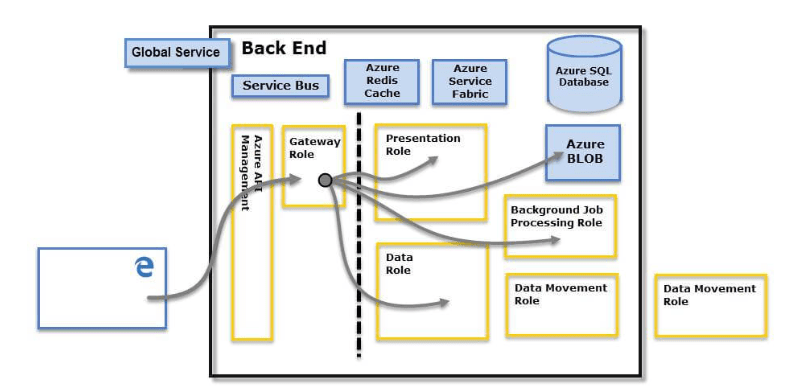Power BI Certification Training Course: PwC A ...
- 101k Enrolled Learners
- Weekend/Weekday
- Live Class
Power BI is the umbrella term for data visualization, reporting, and analytics tools and services from Microsoft. Power BI can import data from various sources and organize them to run queries, build reporting dashboards and data visualization. Power BI has a set of components available for different platforms and purposes.
So, let’s start this Power BI Architecture Tutorial.
The Power BI architecture is a service built upon Azure. Azure is Microsoft’s cloud computing infrastructure and platform.
This service design is predicated on 2 clusters – the online front (Web Front End) cluster and the back finish (Back End) cluster. The Web Front End cluster is liable for initial association and authentication to the ability bismuth service, and once documented, the back finish cluster handles all resultant user interactions.
Power BI gateway is connected on-premise data sources to Power BI Desktop or Power BI cloud services to get continuous data for reporting and analytics.

You may go through this Microsoft Power BI recording where our expert has explained the topics in a detailed manner with examples that will help you to understand the concepts better.
Web front end sees to the initial connection, client authentication and request routing to nearest data centers in Power BI. Power BI uses Azure Traffic Manager (ATM) to direct user traffic to the nearest data-center, determined by the Domain Name System(DNS) record of the clientele attempting to connect to Power BI for the authentication process and to download static content and files. Power BI also uses the Azure Content Delivery Network (CDN) to efficiently distribute the necessary static content and files to users based on geographical location.
 The Back End Cluster in Power BI Architecture
The Back End Cluster in Power BI ArchitectureThe Back finish cluster manages the visualization, user dashboards, data-sets, reports, data storage, data connections, data refresh in Power BI services.
Power BI gateway is connected on-premise data sources to Power BI Desktop or Power BI cloud services to get continuous data for reporting and analytics. It basically acts as a gateway between users and Power BI services. Users don’t act directly with any roles but the gateway Role. 
All data is stored in Azure BLOB storage and user azure storage account and authenticated by Azure Active Directory.
Data Storage Security
The Power BI architecture uses 2 primary repositories for storing and managing knowledge.
The data that’s uploaded from users are often sent to Azure BLOB storage, and everyone data additionally as artifacts for the system itself square measure keep in Azure SQL information.
The line within the back end cluster image, as seen in the previous section on the left of the dotted line, clarifies the boundary between the sole 2 elements that square measure accessible by users, and roles that square measure solely accessible by the system.
Once an associate documented user connects to the service, the association and any request by the consumer is accepted and managed by the gateway role, eventually to be handled by Azure API Management.
This then interacts on the user’s behalf with the remainder of the Service. Additionally, once a consumer makes an attempt to look at a dashboard, the gateway Role accepts that request then individually sends a letter of invitation to the Presentation Role to retrieve the information required by the browser to render the dashboard.
Learn how to implement powerful Row-Level Security in Power BI strategies with our in-depth guide.
Users log in to the service via the e-mail address used to establish their Power BI Services account.
The architecture of Power BI users that login email because of the effective username, that is passed to resources whenever a user makes an attempt to access a piece of information. The effective username is mapped to a User Principal Name (UPN) and all resolve associated to the windows domain account, apply to it.
For organizations that use work emails for Power BI architecture login (such as username@mail.com), the effective username to UPN mapping is easy. For organizations that fail to use work emails for Power BI architecture login, a mapping between the AAD and on-premises credentials would force directory synchronization on to it.
Platform security for architecture includes multi-tenant surroundings security, and networking security, therefore, the ability to feature extra AAD-based security measures.
As described earlier in this article, a user’s Power BI architecture login is employed by on-premises Active Directory servers to map to a UPN for credentials. However, it’s crucial to notice that users square measure liable for they share. If a user connected to data sources victimizes her credentials and shares a report supported that data, the users with whom the dashboard is shared cannot be granted access to the report.
An exception to this is the connection to SQL Server associate analysis Services. Access to underlying reports or data sets initiates authentication for the user making an attempt to access the report. And access can solely be granted if the user has spare credentials to access the info.
So, this was all about Microsoft Power BI Architecture Tutorial. Hope you like this explanation.
If you wish to learn Power BI and build a career in data visualization or BI, then check out our Power BI Course which comes with instructor-led live training and real-life project experience. This training will help you understand Power BI in-depth and help you achieve mastery over the subject.
Related Queries
What coding languages or tools can I integrate with Power BI for advanced analytics?
Got a question for us? Please mention it in the comments section and we will get back to you.
 Thank you for registering Join Edureka Meetup community for 100+ Free Webinars each month JOIN MEETUP GROUP
Thank you for registering Join Edureka Meetup community for 100+ Free Webinars each month JOIN MEETUP GROUPedureka.co